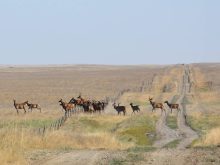Health Canada proposes to end the use of strychnine to control ground squirrels and is seeking public input on the matter until Sept. 27.
The proposal stems from a regular review of pesticides under the Pest Management Regulatory Agency.
In its consultation document, Health Canada said strychnine kills ground squirrels, also commonly called gophers, but it also kills non-target species that might eat either the poison-treated grain used to attract gophers or scavengers that eat the dead rodents.
Read Also

Crop quality looks good this year across Prairies
Crop quality looks real good this year, with the exception of durum.
Health Canada said a risk assessment showed endangered species including burrowing owls and swift foxes can be affected. Songbirds, eagles, hawks, owls, ravens, coyotes and dogs have died as a result of either eating poisoned bait or from secondary poisoning from eating dead gophers.
Its risk assessment also suggested the number of non-target animals affected by strychnine use is difficult to determine and is likely underestimated.
Two types of products are registered in Saskatchewan and Alberta to control gophers: ready-to-use baits and a two percent concentrate that can be mixed into grain by users. Manitoba no longer permits the use of strychnine.
Oneil Carlier, Alberta minister of agriculture, said effective pest management tools are important but alternatives are available.
“We are looking at ways to use existing alternatives to control the pest more effectively and to develop permanent, proactive solutions and strategies to manage ground squirrel damage, including the development of an integrated pest management strategy,” said Carlier.
“Alberta’s Agriculture and Forestry will work with the federal government to ensure our producers have the tools necessary so there’s no disruption in operations.”
Available alternatives for control include anti-coagulant baits, zinc phosphide baits, aluminum phosphide fumigant and white mustard seed powder and sodium alpha-olefin sulfonate used as foam.
Other strategies for gopher control include shooting, trapping, installing raptor platforms and altering fields to provide better predator habitat.
In its proposal, Health Canada said strychnine product labels require users to monitor their fields after application and burn or bury any treated bait or poisoned carcasses found on the surface. However, it also noted those requirements were not necessarily practical for users dealing with large areas and it is hard to find carcasses before scavengers do.
“Risks of concern for non-target poisonings continue to occur with the use of strychnine for the control of ground squirrels,” Health Canada said in its proposal.
“Reliance on strychnine is not sustainable in the long-term due to its lack of practical mitigation measure required to protect non-target organisms as well as documented incident reports, and availability of replacement products.”
Alberta Agriculture data notes the damage ground squirrels can do to crops, equipment and landscaping. However, it recommends control methods other than poison.
“The most common control response to ground squirrel damage is to set out poisoned food-based baits. This approach has long been the recommended standard control since poisons are convenient to use and reasonably cheap, while the results are obvious and reasonably rapid,” the government said in its fact sheet.
“However, studies have shown that for overall long-term effect, food-based poisons are a poor choice. Control with this approach is only short term, and re-invasion usually occurs fairly quickly, so the poisoning process must be repeated.”


















